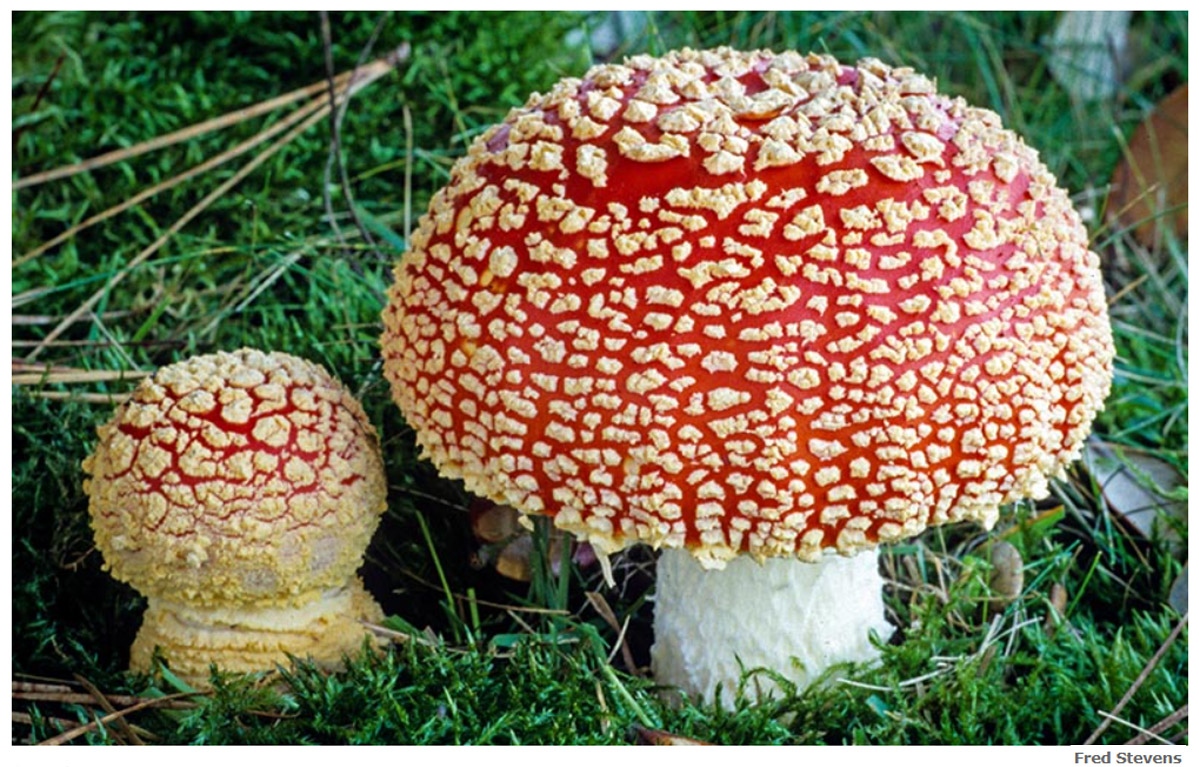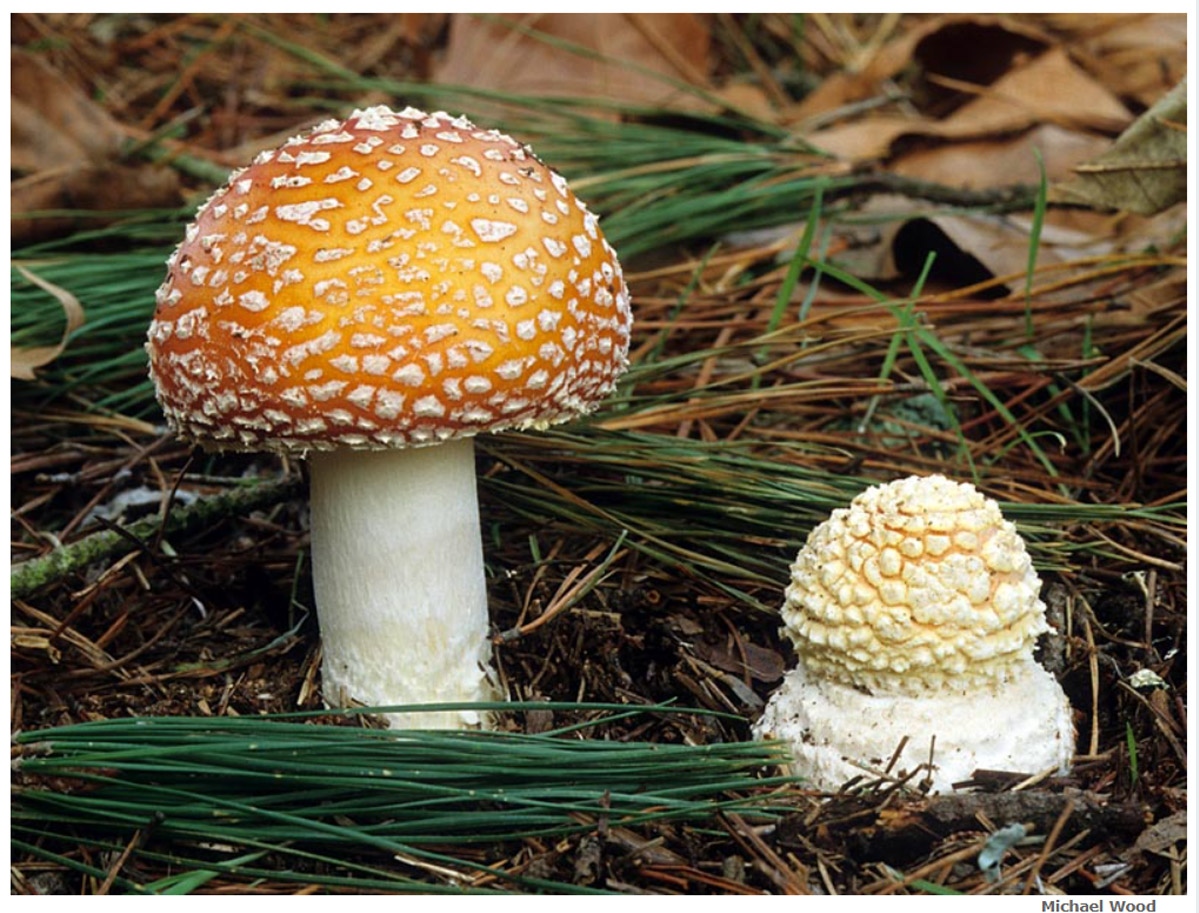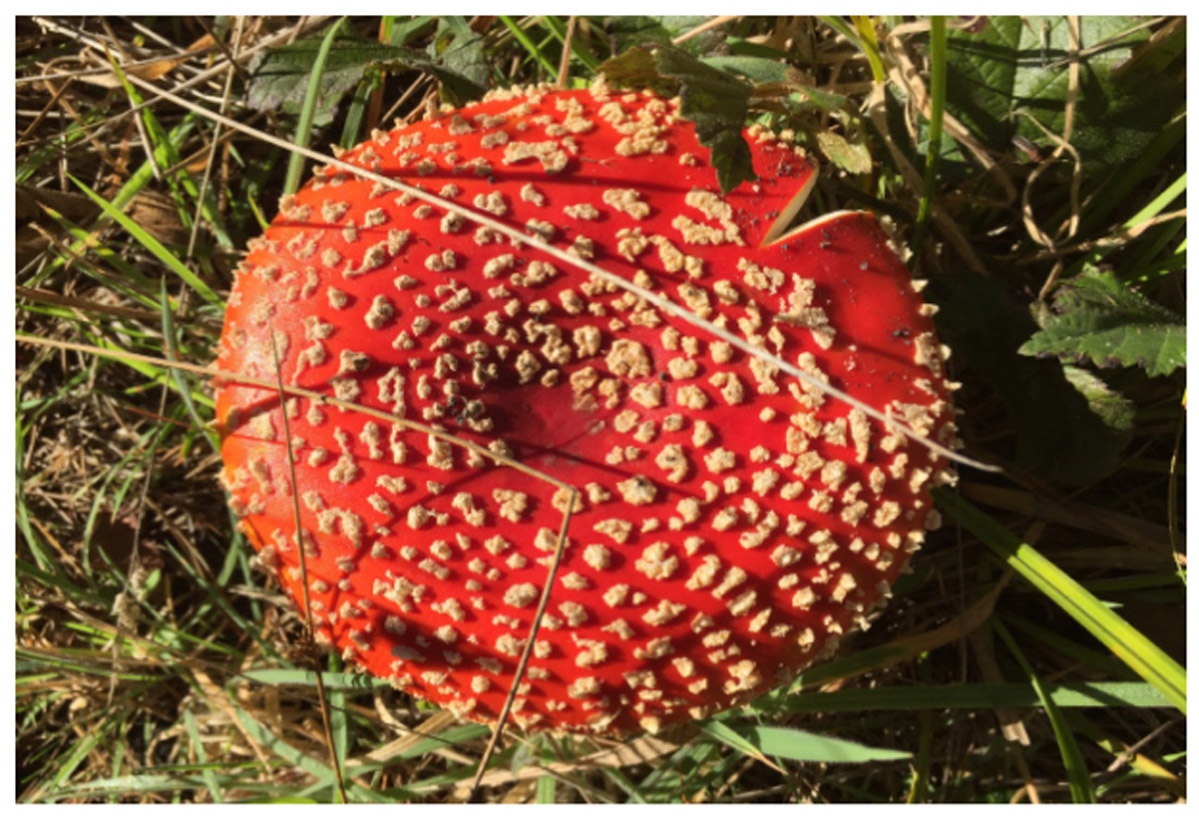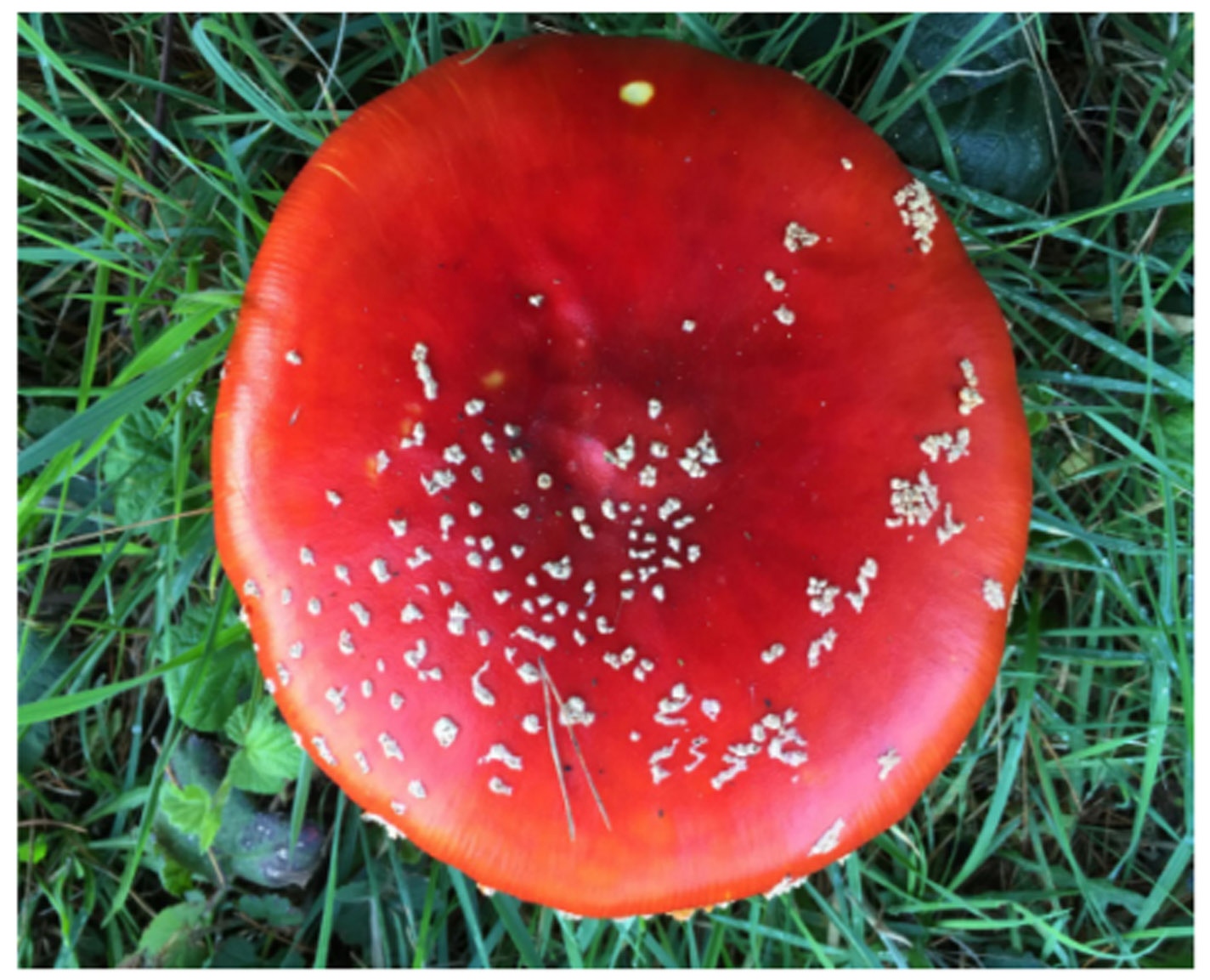|
| |
Mushroom ProfileAmanita muscaria
This month’s mushroom profile is one of my favorites, December’s Santa mushroom. While prevalent at other times of the year in other places with more extensive rainy seasons, in the SF bay area the height of its season is the holidays. One of the most elegant, beautiful, and recognizable mushrooms in the world, the Santa mushroom is not only cosmopolitan and common, but also rich in lore and stately in demeanor, yet cuddly and not lugubrious, just like Santa himself. Decked in cheery cherry red and decoupaged with puffs of fluffy white, the Santa’s cap jingles atop its ivory bearded veil leading down the long white chimney stipe to the skirty cummerbund constricting the top of the bulbous jolly belly.The Santa Mushroom, Fly Agaric Ken Litchfield  One of the many fruits of the roots of the pine, the Santa’s red and white stop sign hohohoheyheyhey heralds from a distance the nearby presence of its associated shy porky little porcini buddy, drably disguised mushrumping among the pine needles -- the most tabloid-worthy mushroom couple in the world. There they hang with an entourage of other semifamous fungi further down the alphabet of celebrity lists like matsies, men-on-horseback, delicious slippery jacks and their hangers-on, the pine spikes. One of the many fruits of the roots of the pine, the Santa’s red and white stop sign hohohoheyheyhey heralds from a distance the nearby presence of its associated shy porky little porcini buddy, drably disguised mushrumping among the pine needles -- the most tabloid-worthy mushroom couple in the world. There they hang with an entourage of other semifamous fungi further down the alphabet of celebrity lists like matsies, men-on-horseback, delicious slippery jacks and their hangers-on, the pine spikes.Not only is the Santa mushroom one of my favorites, it’s one of the world’s favorites. From kitchykoo knickynacks at doilyworld.com to coo-coo theories about legendary origins for the icons of religion, ecstasy, and gift giving, the Santa mushroom’s distinctive look and inherent pharmacology is loaded with wazoo volumes of scrumptious lore. Perhaps you’ve heard of the two constituents or “toxins” in its sap, ibotenic acid and muscimol, that when its flesh is eaten the first toxin is converted into more of the latter by the mammalian physiology so that the urine excreted by the eater is more “toxic” yet desirable than the original mushroom. If the excreter be a human, the resultant yellow snow is such a great attractant for any reindeer in the vicinity that they supposedly trample the pee-er to get to the snow. Makes you wonder why anyone leaves red and white icing cookies around the base of the fireplace holiday pine to trap Santa when you could just eat this mushroom and pee on the roof for his reindeer. Surely the resultant prancing and pawing would pause St. Nick. Now there’s a holiday tradition.  Perhaps you’ve heard that these mushrooms, provided by a Siberian welcoming party, were a favorite unprovable yet suspicious murder technique in the offing for naïve revolutionary Bolshevik commissars sent by Moscow to overlord the Siberian locals -- death by reindeer trampling. Or maybe you’ve heard the tale of the tzarist one-percenters who would eat recreational quantities of these mushrooms in their palaces and venture out to the Moscow street curbs, to trickle down their benefits to the groveling Rus riff-raff that collected the flows in bowls and cups. So arose the term “peons” for the 99ers. Perhaps you’ve heard that these mushrooms, provided by a Siberian welcoming party, were a favorite unprovable yet suspicious murder technique in the offing for naïve revolutionary Bolshevik commissars sent by Moscow to overlord the Siberian locals -- death by reindeer trampling. Or maybe you’ve heard the tale of the tzarist one-percenters who would eat recreational quantities of these mushrooms in their palaces and venture out to the Moscow street curbs, to trickle down their benefits to the groveling Rus riff-raff that collected the flows in bowls and cups. So arose the term “peons” for the 99ers.Maybe you’ve heard about the stories of this mushroom and its influence on the beginnings of Christianity. Or the pillaging of the Vikings. Or the visions of Soma. There is a mini industry of books touting the lore of the Santa mushroom throughout the history of its use in various parts of the world, which you can google to fill your leisure time for months and years to come. At this point whether each of these stories has credibility no longer matters, as the mushroom has transcended the credibility of its storytellers to embody them all. Due to some of the constituent toxins like ibotenic acid, muscimol, and muscarine this mushroom is sometimes characterized erroneously as deadly, when most of this reputation is unverifiable. Perhaps the average adult would have to eat over a dozen of them to be at any real risk, not a very realistic likelihood considering its raw flavor fresh or dried. And those trying to get high usually don’t need more than a half a cap to two or three to be plenty distracted by side effects of nausea, vomiting, diarrhea, sweats, chills, delirium, mood changes, euphoria, depression, sleepiness, excitement, salivation, cotton mouth, lack of physical coordination, blurred vision, auditory and visual hallucinations, and amnesia.  However, properly prepared the Santa mushroom is actually a great edible. I think it tastes better than any of the other Amanitas including the coccora and the spring amanita. You can google the paper by Rubel and Arora that discusses the history of the edibility of Amanita muscaria and follow the sometimes elaborate recommendations for preparation from earlier times. However, Arora has a simple parboil twice and However, properly prepared the Santa mushroom is actually a great edible. I think it tastes better than any of the other Amanitas including the coccora and the spring amanita. You can google the paper by Rubel and Arora that discusses the history of the edibility of Amanita muscaria and follow the sometimes elaborate recommendations for preparation from earlier times. However, Arora has a simple parboil twice and discard the water method that he has used many times safely. We have prepared this mushroom many times at MycoMendoMondo with a simple single 10-minute boiling and then sautéing like southern style poke salad. It has the nutty flavor and fine texture of a topnotch edible with no more care needed in prepping than the potentially deadly poisonous morel. discard the water method that he has used many times safely. We have prepared this mushroom many times at MycoMendoMondo with a simple single 10-minute boiling and then sautéing like southern style poke salad. It has the nutty flavor and fine texture of a topnotch edible with no more care needed in prepping than the potentially deadly poisonous morel.If you would like to partake of this mushroom during your holidays, slice two to three average sized mushrooms about an eighth to a quarter inch thick and toss into a pot of three to four times as much volume of roiling boiling water, for about ten minutes. Then strain out the mushroom slices and sauté them in butter until lightly browned (important because the mushroom takes in water after boiling) and add salt and pepper to try them for their own flavor. You could toss the now reddish water or, if you like, you could drink various amounts of it on an empty stomach to see your reaction to the water-soluble constituents. They aren’t heat sensitive like chicken-of-the-woods, so the water retains any of the inebriating effects -- as well as the side effects. And if you would like to grow these beautiful mushrooms in your back yard, be sure to plant one or more of the little living holiday Italian stone pines that make pignolias that you find in the nursery section of drugstores, hardware stores, or big box stores, discounted right after the holidays. You can add a little mixed forest action with doug fir, birch, or Cedrus deodar; all decorative in their own right. Check this month’s Cultivation Quarters for the details on how to cultivate mycorrhizal mushrooms like the Santa mushroom. | |
| Mycena News - Happy New Year |